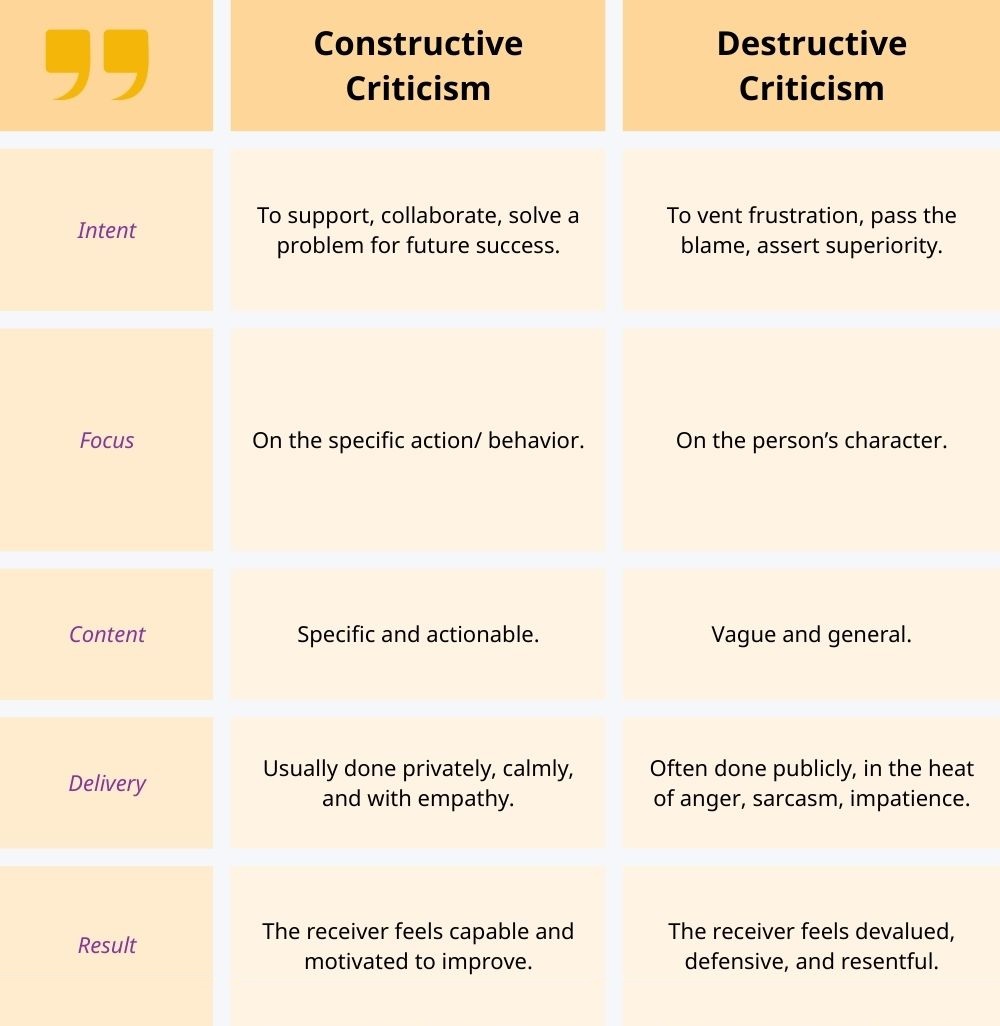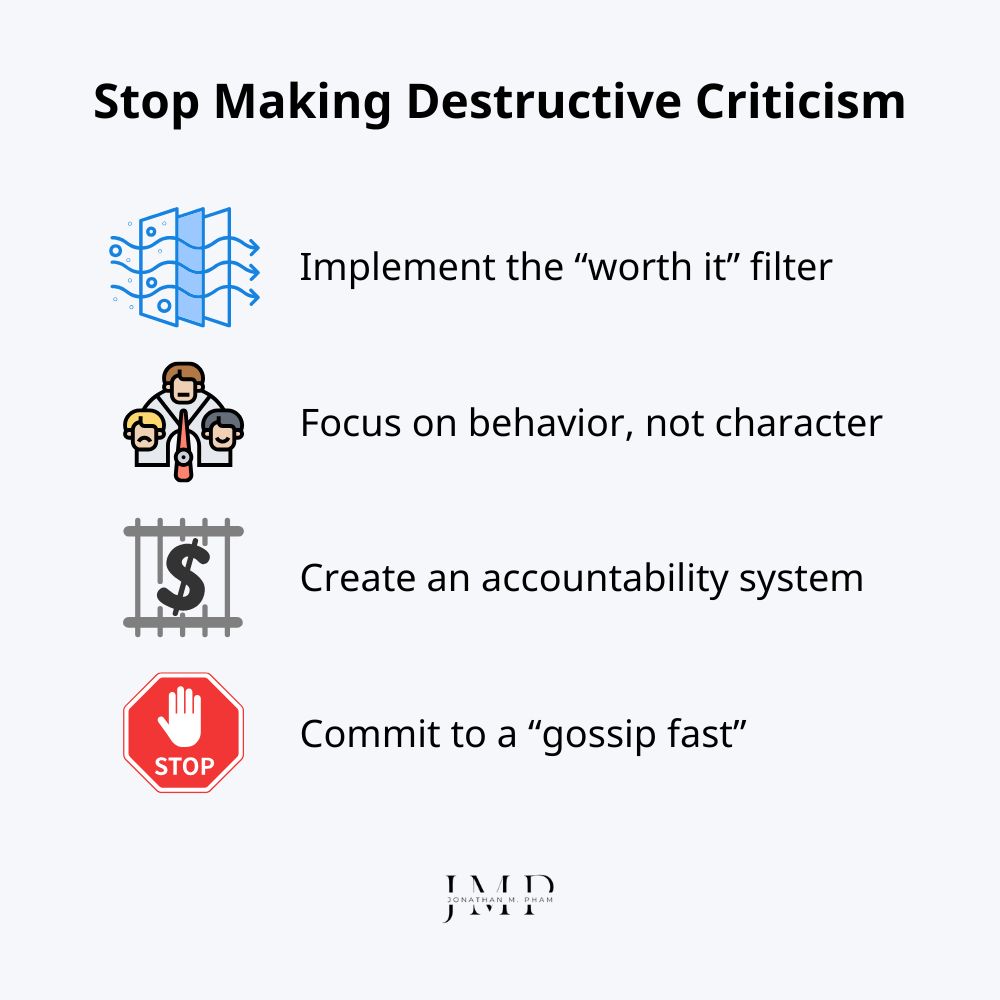Do your words sometimes hurt more than they help? Let us reflect on the bad habit of destructive criticism, why we fall into it, plus practical steps to shift toward a more constructive approach.
It’s funny how a single sentence can change the mood of an entire day. We’ve all felt it, right? That sting when someone makes a passing comment about our work, an idea we’re excited about, or even a choice we’ve made.
It’s not helpful feedback; it’s a remark that feels like a small paper cut on our enthusiasm.
It’s easy to recognize when we’re on the receiving end. But here’s the uncomfortable question I’ve had to ask myself recently: When was the last time I was the one delivering that sting, maybe without even meaning to?
This isn’t an article about pointing fingers, because honestly, I think this is a bad habit most of us share. We fall into destructive criticism – those sarcastic jabs, backhanded compliments, or overly harsh critiques – often because we’re stressed, insecure, or simply not thinking.
As such, my intention here is to reflect on why we do it, how to spot it in our own words, and how we can consciously choose a kinder, more effective way to communicate.
Highlights
- Destructive criticism is feedback that aims to devalue a person rather than improve an action, often delivered through personal attacks, sarcasm, or vague complaints. It erodes trust in relationships and stifles creativity by making people afraid to take risks.
- Typically driven by underlying insecurity, stress, or a need to feel superior, destructive criticism manifests in both obvious ways (mockery, blame) and subtle forms (backhanded compliments, dismissive remarks, gossip) that we may not even be aware of.
- We can break the habit by cultivating self-awareness through reflection, implementing a pause before speaking, filtering our comments for helpfulness rather than harshness, and focusing on specific behaviors instead of personal character.
What is Destructive Criticism?
Our tendency (which is understandable) is to justify harsh words by labeling them “tough love” or “brutal honesty.” But I’ve learned that true tough love, while firm, still has a foundation of care and a goal of improvement. Destructive criticism, on the other hand, drops the “love” part entirely and focuses more on the “tough.”
At its core, destructive criticism (also referred to as “destructive feedback”, “toxic criticism”, “judgemental feedback”, “non constructive feedback”) is feedback that aims to devalue or hurt, rather than build up or solve a problem. It stops focusing on what a person did and starts attacking who the person is.
For example, think about the difference between saying, “I noticed there were a few calculation errors in the budget spreadsheet; let’s fix them before the meeting,” and saying, “This budget spreadsheet is a complete mess. Do you ever double-check your work?“
As you may see, the first comment identifies a problem and demonstrates a spirit of collaboration. On the other hand, the second one assigns blame and attacks competence. It’s vague (“a complete mess”) and presents no clear path forward – except feeling bad.
Many times, this kind of criticism carries a negative emotional charge – sarcasm, impatience, or contempt. It’s the difference between “I’m concerned about your health” and “I can’t believe you’re eating that.”
The primary outcome isn’t growth, but simply making someone else feel small.
Destructive comments are the cutting sarcastic remarks we spew out daily, with or without intention, that serve no other purpose than to put people down, hurt them, or assert ourselves as their superiors.
Marshall Goldsmith

Opposite of constructive feedback
Key characteristics of destructive feedback:
- Non-specific (“This whole project is a mess.”)
- Personal attacks or labels (“You’re lazy/incompetent.”)
- Delivered with negativity.
- Lacks actionable advice for improvement.
Constructive Criticism vs Destructive Criticism
Every time we feel the urge to comment on someone else’s actions, we face a choice. Will our words serve to build that person up, or will they tear them down? This choice is the fundamental difference between constructive help and destructive hurt.
I used to think that any feedback that wasn’t positive was inherently negative. However, constructive criticism, even when it addresses a flaw, is ultimately an act of care. It’s saying, “I value our relationship and your potential enough to have this slightly uncomfortable conversation with you for a better outcome.”
Destructive criticism, in contrast, prioritizes venting our own frustration over the other person’s growth. It’s less about a shared goal and more about winning the moment.
Think of one approach as being an ally and the other as being an attacker.
| Characteristic | Constructive Criticism (The Ally) | Destructive Criticism (The Attacker) |
| The Core Intent | To help, support, collaborate, or solve a problem for future success. | To vent frustration, pass the blame, assert superiority, or hurt someone’s feelings. |
| The Focus | On the specific action or behavior that can be changed (“The timing of the report submission…”). | On the person’s character or identity (“You are so unreliable…”). |
| The Content | Specific and actionable. It points out the issue clearly and suggests a path for improvement. | Vague and general. It uses sweeping words like “always,” “never,” or “everything.” (“You mess this up constantly.”) |
| The Delivery | Usually done privately, calmly, and with empathy for the person’s feelings. | Often done publicly, in the heat of anger, or with sarcasm and impatience. |
| The Resulting Feeling | The receiver feels capable and motivated to improve, even if they feel a little disappointed initially. | The receiver feels devalued, defensive, resentful, and hopeless about changing. |
The difference between constructive and non-constructive criticism
For instance, imagine a friend is consistently late when meeting up.
- Destructive response: “Seriously? You’re late again. I don’t know why I even bother trying to make plans with you. It’s so disrespectful.”
- Constructive response: “Hey, I noticed we’ve had trouble meeting up on time lately. I feel a bit frustrated when I wait for a while by myself. Can we try setting our meet-up time 15 minutes earlier than we actually need to be there, or figure out a better plan?”
Both approaches address the same problem, but only one opens the door to a solution without making the other person feel attacked.

Types of Destructive Criticism
Destructive criticism rarely introduces itself honestly. Let’s look at some of its favorite “costumes”, from the obvious to the deceptively subtle.
The obvious attacks
These are the easiest to spot. The intent to diminish someone is barely concealed; it is typically hidden behind a thin veil of sarcasm or authority.
- Mockery and sarcasm: This is criticism disguised as humor, where the joke comes at someone else’s expense. It’s saying something positive with a negative tone, like, “Oh, another one of your great ideas? This should be interesting.” It gives the speaker plausible deniability (“I was just kidding!”) while ensuring the sting lands.
- Gossip (the indirect assault): A particularly sneaky form, because we’re not even talking to the person involved. We vent our frustration about a colleague to a coworker, or complain about a family member to another relative. We might feel justified, but what we do is, eventually, not helpful at all. The only thing it does is breaking down trust, preventing direct resolution, and creating a toxic environment behind the scenes.
Gossip is when a negative is discussed with anyone who can’t fix the problem.
Dave Ramsey
The subtle jabs
This category was the biggest eye-opener for me, as these are phrases I’ve used myself without considering their impact. They seem trivial, but they effectively shut down potential and devalue effort.
- The minimizer: Have you ever worked hard on something, only to have someone say, “Oh, that’s simple”? This comment, along with “Is that all you did?” or “That shouldn’t have taken you so long,” invalidates the work you put in. It implies incompetence for finding a task challenging.
- The dismissive stopper: These phrases kill a conversation instantly. When someone shares an idea and gets hit with a flat “That won’t work,” “Whatever,” or even a patronizing “Nice try,” there’s no room for discussion. It doesn’t invite improvement; it signals rejection.
- The backhanded compliment: A classic passive-aggressive technique. “Wow, I’m genuinely surprised you pulled that off!” or “You clean up really well!” The compliment part is just a delivery system for the underlying message of low expectations.
When we utter these seemingly “harmless” comments, we often tell ourselves we’re just being realistic or efficient. But in reality, we’re building up an environment where people feel less safe to try, to share, or to be themselves around us.

Deconstructive feedback
Our Shared Blind Spot: “I Never Said That, Did I?”
Here’s where the self-reflection gets a little deeper and, for me, a little more uncomfortable. It’s one thing to identify destructive criticism when we see it happen between other people. And yet, it’s another thing entirely to accurately track how often we do it ourselves.
The biggest challenge with this bad habit is that our perception as the speaker is, most of the time, completely different from the reality experienced by the listener. How many times have you made a quick, throwaway comment, only to forget it seconds later?
For us, it was insignificant. But for the person who received it, that comment might have replayed in their mind all afternoon.
We judge ourselves by our intentions (“I was just trying to be funny” or “I was stressed”), while others judge us by our impact.
Leadership expert Marshall Goldsmith once shared a story that went like this:
One of my clients told me that for his fortieth birthday, his colleagues and friends held a “roast” where the evening’s theme required everyone to recite one biting remark that he had made over the years at their expense. An interesting gambit: They were making fun of the birthday boy by revisiting the times he had made fun of them. It was a raucous, hilarious evening.
“Here’s the thing,” said my client. “Of the dozens of nasty funny comments I heard that night, I didn’t remember saying one of them. That’s how thoughtless they were. Also, my friends didn’t hate me for it. They may be called ‘destructive’ comments but in my group they didn’t do any destruction. People considered it a part of who I am, and it wasn’t a problem.”
He was right; it wasn’t. That’s the other interesting thing about destructive comments. We think it’s common but statistically it’s only a problem in 15 percent of my clients. That doesn’t mean the other 85 percent of the world is not guilty of making destructive comments. We all make them every day. It indicates that only 15 percent of us do it to the point where it is a problem with our colleagues.
What you need to find out is whether that 15 percent includes you.
While most of us aren’t malicious, we all make destructive comments more frequently than we think. We might believe our relationships are strong enough to withstand these little jabs, but we rarely stop to consider the cumulative effect.
This blind spot – the gap between the words we remember saying and the words people remember hearing – is where destructive habits thrive.
What’s important here, though, is not to be concerned about whether we’re “bad people” – but to acknowledge that we have a responsibility to check for impact, not just rely on our good intentions.
Read more: Not Listening – The Silent Killer in Life
Why Do We Make Destructive Criticisms?
If destructive criticism causes harm – and we all recognize it in others, why do we continue to do it ourselves?
For a long time, I assumed it was just a bad habit, like cracking knuckles. But when I reflect on the times I’ve been unnecessarily sharp or dismissive, I realize it’s almost always deeper than that.
People rarely lash out when they feel secure, happy, and content. Destructive criticism is, many times, an emotional snapshot of our own internal state – a symptom of something else going on beneath the surface.
Here are a few common reasons I’ve observed in myself and others:
- It’s a shield for insecurity
This is perhaps the biggest driver. When we feel inadequate, small, or “less than,” putting someone else down gives us a temporary, false sense of superiority.
If I can point out a flaw in your reasoning, I momentarily feel smarter.
If I criticize your choice, I momentarily feel more secure in my own.
It’s a classic defense mechanism – a quick attempt to level the playing field when we feel like we’re losing.
- Stress and emotional exhaustion
Think about how you feel and think when you’re well-rested and calm versus when you’re stressed, running late, and juggling five different problems. When our emotional resources are depleted, our patience and empathy are the first casualties.
The critical comment that slips out isn’t pre-meditated; it’s a direct result of having no energy left to filter ourselves.
It’s easier to lash out than to summon the energy for constructive dialogue.
- A need for control and deflection
When things feel chaotic, many of us attempt to regain control through the use of criticism (which is a misguided effort, after all). By pointing out what’s wrong, we position ourselves as being in charge or holding higher standards.
Sometimes, it’s also a way to shirk responsibility. If I find fault with how you handled a task, it diverts attention from the part I failed to complete.
It’s easier to focus on the problem someone else created than to contribute to finding a solution.
- It’s a learned behavior
We often communicate how we were taught to communicate. If we grew up in a family or worked in an environment where sarcasm, blunt critiques, and “teasing” were standard practice, we may have internalized this as a normal – or even effective – way to interact.
We replicate the patterns we’ve seen, especially from those in authority, without ever stopping to question if they truly align with the kind of person we want to be.

Destructive feedback psychology
Understanding these triggers doesn’t excuse the behavior, but it does illuminate the path forward. It shows us that becoming a better communicator starts with addressing our own stress, insecurities, and learned habits.
Read more: Making Excuses – How to Break Free from this Cycle
The Effects of Destructive Criticism: Why We Must Stop this Bad Habit
It’s easy to assume, “They know I didn’t mean it,” or “It’s just words, they’ll get over it.” But the truth is, words create emotional realities. Like a stone dropped in a pond, a destructive comment creates ripples that travel far beyond the initial splash, impacting relationships, environments, and even our own sense of self.
When we examine the true cost, it becomes clear why shifting this habit is so crucial for a healthier life.
- It kills motivation and stifles growth in others
The most immediate effect of destructive criticism is on the receiver’s motivation. When someone’s effort is met with sarcasm or a vague dismissal (“This isn’t good enough”), they don’t learn how to improve; they learn that trying is risky.
E.g. Think about a time you were genuinely excited about something until someone’s negativity deflated you. You didn’t just abandon the idea; a little bit of your spark went out with it.
Destructive criticism is the biggest single enemy of human potential. It is worse than cancer or heart disease. While those diseases can ultimately lead to the deterioration and death of an individual, destructive criticism kills the soul of the person but leaves the body walking around.
Brian Tracy
- It creates a culture of fear and “yes-men”
In a group setting – whether a family or an office team – this ripple effect is amplified. When a leader or dominant member frequently uses cutting criticism, others quickly learn that silence is safer than vulnerability. As such, people stop sharing creative ideas for fear of being shot down.
They stop admitting mistakes for fear of personal attacks.
The result isn’t a stronger team; it’s a team full of “yes-men” who nod along to avoid conflict, while frustration and resentment simmer beneath the surface.
Trust evaporates because emotional safety has disappeared.
- It harms our own wellbeing and reputation
This, for me, was the most compelling reason for change. The negativity we put out into the world inevitably circles back to us – always.
When we constantly practice finding fault in others, we train our brains to see the bad before the good. We become known as the negative person, the complainer, or the one who is difficult to be around.
We might think we’re projecting strength, but we’re actually isolating ourselves and living in a state of self-imposed negativity.
Kindness benefits the giver as much as, if not more than, the receiver.
Those who are kind benefit themselves, but the cruel bring ruin on themselves.
Proverbs 11:17
Destructive feedback is non-motivational
How to Move from Destructive to Constructive Feedback
The good news is that because destructive criticism is a habit, it can be rewired. The goal isn’t to become perfectly eloquent overnight or to never have a negative thought again. Rather, it is to catch ourselves, pause, and pick a better path more often than not.
The following process involves shifting one’s mindset from being a critic (who judges and lives in the past) to being a coach (who improves and aims for the future). Here are a few practical strategies I’ve found helpful on the journey.
Implement the “worth it” filter
Before you speak, especially when feeling frustrated or annoyed, take a breath and think. As suggested by Dr. Marshall Goldsmith, we should stop wondering, “Is what we are about to say true?” – because often, it is factually true. Instead, ask yourself: “Is it worth it?”
Before making that comment, try to do a quick assessment in your mind:
- Will this actually help the person or situation?
- Will this improve our relationship?
- Is this the right time and place?
- etc.
If the answer to these questions is no, the best course of action is often silence.
In fact, I’ve found this simple pause saves me from countless moments of regret. It shifts the goal from proving I’m right to creating a positive outcome for everyone.
Focus on behavior, not character
When feedback truly is necessary, make it about the specific action, not the person’s identity. This is the core principle of constructive feedback.
Instead of launching personal attacks like “You’re so disorganized,” focus on the observable issue: “I noticed the project files were hard to find this week. Can we work together on a better labeling system?”
In changing the approach, we invite collaboration rather than triggering defensiveness. We frame the issue as a solvable problem, not a permanent personality flaw.
Create an accountability system
Marshall Goldsmith once shared a brilliant and humbling story about how he tackled his own high level of destructive comments as follows:
So I talked to my staff. I said, “I feel good about much of my feedback. Here’s one thing I want to do better: Quit making destructive comments. If you ever hear me make another destructive comment about another person, I’ll pay you $10 each time you bring it to my attention. I’m going to break this habit.”
Then I launched into an emotional pep talk, encouraging them to be honest and diligent about “helping” me. Turns out it wasn’t necessary. In fact, they would trick me into making nasty comments because they wanted the $10. They’d mention names of people guaranteed to bring up some bile – and I took the bait each time.
They mentioned a colleague named Max and I said, “Can you believe he has a Ph.D? He has no idea what he’s talking about.” Ten bucks.
A customer called and I remarked, “He’s too cheap to pay.” Ten bucks.
By noon, I was down $50. I locked myself in my office and refused to speak to anyone for the rest of the day.
Of course, hiding helps you avoid the issue; it doesn’t help you fix it. But the financial pain got me thinking in the right direction.
The next day my nasty comments cost me $30. The third day, $10.
This policy was in force in our office for several weeks. And it cost me money.
But eventually I brought my score up to the 96th percentile. I don’t make destructive comments anymore – at least not so it’s a problem.
Indeed, it’s hard to break a habit that has no immediate consequences for us – that’s why an accountability system is essential. While we don’t need to use cash, we can come up with an alternative solution. For example, tell a trusted friend, coach, mentor, or accountability partner, “I’m really trying to stop making sarcastic jabs. Could you gently point it out to me when I do it?”
Creating an external feedback loop breaks through our internal blind spot and accelerates change.
Commit to a “gossip fast”
A simple rule I try to live by: If I have an issue with someone, I talk to them. If I don’t have an issue with them, I only talk about them in a positive light. This means actively refusing to participate in negative discussions about people who aren’t present.
It’s challenging at first, but it’s the fastest way to cultivate integrity and trust.
When you eliminate gossip, you force yourself to either address problems constructively or let them go entirely.
Read more: Emotional Intelligence (EQ) – Key to a More Abundant Life

Personal Reflection: A Pause Before Speaking
Knowledge is powerful, but change only happens when we apply that knowledge to our own lives. We’ve explored what destructive criticism is, why we do it, and how we can start shifting our approach. Now, let’s make it personal with a few gentle prompts for reflection.
There’s no judgment here. The goal is simply to build the muscle of self-awareness. You might want to think about these questions now, or perhaps save them for a quiet moment of journaling later on.
- Recall the feeling: Think about the last time a comment truly demotivated you or stung in a lasting way. What specific element made it feel destructive rather than helpful? Was it the public setting, the sarcastic tone, the personal nature of the attack, or the fact that it offered no solution?
- Identify your triggers: When are you most likely to slip into making a critical remark? Reflect on your internal state during those moments. Are you in a hurry? Feeling stressed about finances? Interacting with a specific person? Or perhaps feeling insecure about your own performance?
- Practice the “motive check”: Before you offer feedback or make a potentially sharp comment in the coming week, practice pausing and asking yourself: “What is my true motive right now? Am I trying to help this person succeed, or am I just trying to vent my frustration or prove I’m right?”
- Acknowledge the alternative: Think about a recent situation where you gave (or were tempted to give) criticism. How could you have rephrased your concern using the “Ally” approach (focusing on behavior and collaborative solutions)?
Taking a few moments for this kind of regular self-check helps transition these ideas from concepts you’ve read about to actions you live by.
Read more: 110 Self Discovery Journal Prompts by Topic
Destructive Criticism Quotes
Check out a full list of feedback quotes here!
The more feedback you give to people, the better it is, as long as the feedback is objective and not critical.
Brian Tracy
Positive criticism is feedback given with the purpose of helping another person to grow and to develop. Negative criticism is intended to hurt and often to defame and to destroy.
L. Lionel Kendrick
When you are giving feedback, try to be descriptive and minimize judgment.
Edgar H. Schein
The most destructive criticism is indifference.
E. W. Howe
How to overcome destructive criticism? Just love a little more. That’s all.
Sri Chinmoy
Bonus: How to Deal with Destructive Criticism
While the focus of this article is on changing our own habit of giving destructive feedback, we will inevitably remain on the receiving end from time to time. When that happens, remember these quick points:
- Don’t automatically absorb it. Pause before reacting. Recognize that the criticism, especially if delivered poorly, often says more about the giver’s stress level or insecurities than it does about your actual worth.
- Filter for the kernel of truth. Ask yourself, “Setting aside the harsh delivery, is there one tiny piece of valid information here I can learn from?” Take that single piece, if it exists, and discard the emotional baggage that came with it.
- It’s okay to set boundaries. You don’t have to accept abuse disguised as feedback. For persistent critics, it’s perfectly acceptable to say, “I’m open to feedback, but I find it difficult to move forward when the conversation feels personal or hostile.”
Final Thoughts
If you recognize yourself in the examples above, don’t panic – it’s a sign that you’re human. As mentioned, I don’t expect everyone to be able to eliminate every critical impulse after finishing this reflection. Rather, my intention is to help you shorten the gap between impulse and awareness, from which each of us may consciously decides to tread a path that promotes connection rather than division.
At the end of the day, learning to abandon the bad habit of destructive criticism changes more than just our conversations; it fundamentally improves the quality of our relationships. When we make people feel safe around us – safe to try, safe to fail, and safe to be authentic – we create an environment where everyone thrives.
Compiled with inspiration from the bestseller ‘What got you here won’t get you there‘ by Dr. Marshall Goldsmith.
Other resources you might be interested in:
- Adding Too Much Value: Is More Always Better?
- Shooting the Messenger: Why Do We Blame Others for Bad News?
- The Excessive Need to Be Me: When the Ego Takes Over
Let’s Tread the Path Together, Shall We?


